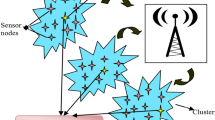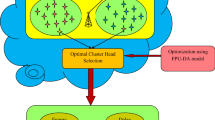Abstract
Clustering is considered as one of the most primitive technique that aids in prolonging the lifetime expectancy of wireless sensor networks (WSNs). But, the process of cluster head selection concerning energy stabilization for the purposed of prolonging the network life expectancy still remains a major issue in WSNs. In this paper, a hybrid grey wolf and crow search optimization algorithm-based optimal cluster head selection (HGWCSOA-OCHS) scheme was proposed for enhancing the lifetime expectancy of the network by concentrating on the minimization of delay, minimization of distance between nodes and energy stabilization. The grey wolf optimization algorithm is hybridized with the crow search optimization algorithm for resolving the issue of premature convergence that prevents it from exploring the search space in an effective manner. This hybridization of GWO and CSO algorithm in the process of cluster head selection maintains the tradeoff between the exploitation and exploration degree in the search space. The simulation experiments are conducted and the results of the proposed HGWCSOA-OCHS scheme is compared with the benchmarked cluster head selection schemes with firefly optimization (FFO), artificial bee colony optimization (ABCO), grey wolf optimization (GWO), firefly cyclic grey wolf optimisation (FCGWO). The proposed HGWCSOA-OCHS scheme confirmed minimized energy consumption, improved network lifetime expectancy by balancing the percentage of alive and dead sensor nodes in the network.










Similar content being viewed by others
References
Prince, T., & Kannan, S. T. (2017). Bat-inspired cluster head selection and on-demand cluster head gateway routing for prolonged network lifetime in MANET. International Journal of Wireless and Mobile Computing,12(4), 419.
Shalini, V. B., & Vasudevan, V. (2017). Achieving energy efficient wireless sensor network by choosing effective cluster head. Cluster Computing,1(1), 23–32.
Sarkar, A., & Senthil Murugan, T. (2017). Cluster head selection for energy efficient and delay-less routing in wireless sensor network. Wireless Networks,25(1), 303–320.
Senthil, M., Rajamani, V., & Kanagachid, G. (2014). Energy-efficient cluster head selection for life time enhancement of wireless sensor networks. Information Technology Journal,13(4), 676–682.
Kaur, H., & Seehra, A. (2014). Performance evaluation of energy efficient clustering protocol for cluster head selection in wireless sensor network. International Journal of Peer to Peer Networks,5(3), 1–13.
Noori, M., & Khoshtarash, A. (2013). BSDCH: New chain routing protocol with best selection double cluster head in wireless sensor networks. Wireless Sensor Network,05(02), 9–13.
Gupta, V., & Sharma, S. K. (2014). Cluster head selection using modified ACO. Advances in Intelligent Systems and Computing,1(1), 11–20. https://doi.org/10.1007/978-81-322-2217-0_2.
Chandirasekaran, D., & Jayabarathi, T. (2017). Cat swarm algorithm in wireless sensor networks for optimized cluster head selection: A real time approach. Cluster Computing,1(1), 12–27.
Sharma, R., Jain, G., & Gupta, S. (2015). Enhanced Cluster-head selection using round robin technique in WSN. 2015 International Conference on Communication Networks (ICCN), 1(1), 32–43.
Praveen Kumar Reddy, M., & Rajasekhara Babu, M. (2017). A hybrid cluster head selection model for Internet of Things. Cluster Computing,1(1), 56–67.
Gupta, G. P. (2018). Improved Cuckoo Search-based Clustering Protocol for Wireless Sensor Networks. Procedia Computer Science,125, 234–240.
Huang, T. (2014). Optimization of routing protocol in wireless sensor networks by improved ant colony and particle swarm algorithm. TELKOMNIKA Indonesian Journal of Electrical Engineering,12(10), 7486–7494.
Gambhir, A., Payal, A., & Arya, R. (2018). Performance analysis of artificial bee colony optimization based clustering protocol in various scenarios of WSN. Procedia Computer Science,132(1), 183–188.
Hult, T., & Mohammed, A. (2016). Cooperative diversity techniques for energy efficient wireless sensor networks. Wireless Sensor Networks and Energy Efficiency,1(1), 262–273.
Singh, V. K. (2017). Routing in wireless sensor networks. Energy-Efficient Wireless Sensor Networks,1(1), 43–68.
Kumar, R., & Kumar, D. (2015). Multi-objective fractional artificial bee colony algorithm to energy aware routing protocol in wireless sensor network. Wireless Networks,22(5), 1461–1474.
Sengathir, J. (2018). A hybrid ant colony and artificial bee colony optimization algorithm-based cluster head selection for IoT. Procedia Computer Science,143(1), 360–366.
Shankar, A., & Jaisankar, N. (2017). Dynamicity of the scout bee phase for an artificial bee colony for optimized cluster head and network parameters for energy efficient sensor routing. Simulation,94(9), 835–847.
Potthuri, S., Shankar, T., & Rajesh, A. (2018). Lifetime improvement in wireless sensor networks using hybrid differential evolution and simulated annealing (DESA). Ain Shams Engineering Journal,9(4), 655–663.
Shankar, T., Shanmugavel, S., & Rajesh, A. (2016). Hybrid HSA and PSO algorithm for energy efficient cluster head selection in wireless sensor networks. Swarm and Evolutionary Computation,30(1), 1–10.
Vijayalakshmi, K., & Anandan, P. (2018). A multi objective Tabu particle swarm optimization for effective cluster head selection in WSN. Cluster Computing,1(2), 67–78.
Baskaran, M., & Sadagopan, C. (2015). Synchronous firefly algorithm for cluster head selection in WSN. The Scientific World Journal,2015(1), 1–7.
Ahmad, T., Haque, M., & Khan, A. M. (2018). An energy-efficient cluster head selection using artificial bees colony optimization for wireless sensor networks. Advances in Nature-Inspired Computing and Applications,1(1), 189–203.
Sharawi, M., & Emary, E. (2017). Impact of grey wolf optimization on WSN cluster formation and lifetime expansion. Proceedings of the 2017 Nineth International Conference on Advanced Computational Intelligence (ICACI), 1(1), 23–35.
Murugan, T. S., & Sarkar, A. (2018). Optimal cluster head selection by hybridisation of firefly and grey wolf optimisation. International Journal of Wireless and Mobile Computing,14(3), 296.
Author information
Authors and Affiliations
Corresponding author
Additional information
Publisher's Note
Springer Nature remains neutral with regard to jurisdictional claims in published maps and institutional affiliations.
Rights and permissions
About this article
Cite this article
Subramanian, P., Sahayaraj, J.M., Senthilkumar, S. et al. A Hybrid Grey Wolf and Crow Search Optimization Algorithm-Based Optimal Cluster Head Selection Scheme for Wireless Sensor Networks. Wireless Pers Commun 113, 905–925 (2020). https://doi.org/10.1007/s11277-020-07259-5
Published:
Issue Date:
DOI: https://doi.org/10.1007/s11277-020-07259-5




